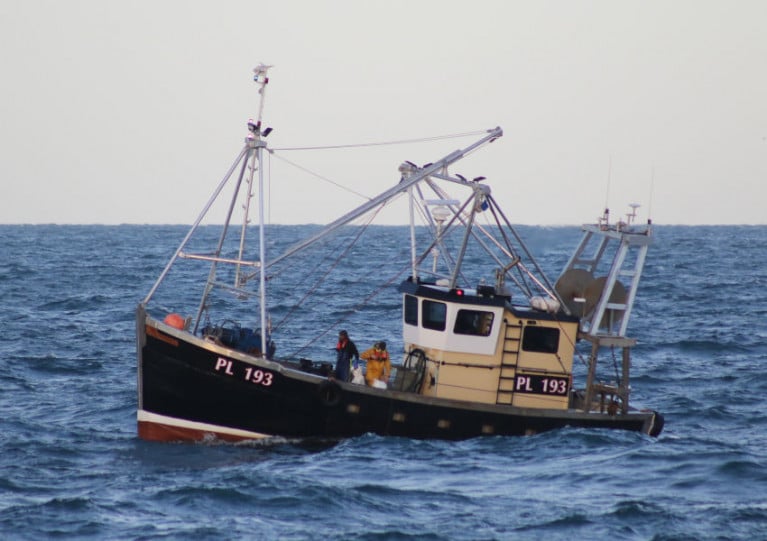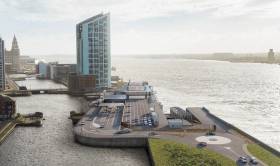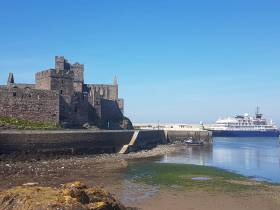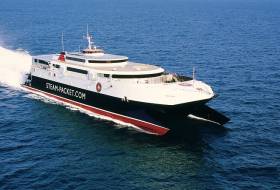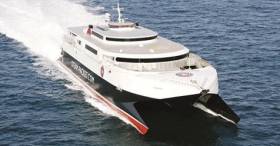Displaying items by tag: Isle of Man
RNLI fishing safety manager Frankie Horne has urged the fishing community to avail of safety training that is on offer for their crews and to ensure that their safety equipment is up to date.
It comes after the skipper of a fishing vessel that sank late last year off the Isle of Man has attributed their rescue to the safety training the crew had undertaken previously and to their lifejackets, which were fitted with personal locator beacons (PLBs).
On the evening of 23 November last year, the fishing vessel Polaris suffered a catastrophic hull failure in the Irish Sea off the west coast of the Isle of Man.
The vessel sank so rapidly that the skipper only had time to send out a Mayday to the coastguard and other surrounding fishing boats before the vessel became submerged.
The coastguard immediately launched two RNLI lifeboats, from Port St Mary and Port Erin, and a rescue helicopter. However, it was a local fishing vessel, Lynn Marie, which arrived first on scene.
The skipper and a crew member from Polaris had been in the water for at least 15-20 minutes before help arrived.
The skipper of the Lynn Marie feared the worst on arriving at the scene as the Polaris had already gone below the water. The skipper stopped his engine to listen for the crew of the Polaris, which proved a wise decision as he heard two men in the water shouting. The Lynn Marie crew located them with a search light and recovered them from the water.
‘I can tell you that there is no doubt that the lifejackets saved our lives’
Commenting on the rescue, Horne said: “After speaking with Gordon Mills, the skipper of the Polaris, and the crew of Lynn Marie on their arrival at Peel, it was quite clear that this could have been a very different story had the crew of both vessels not acted so professionally.
“The crew had attended safety training and wore lifejackets fitted with personal locator beacons which had increased their chances of survival.”
Gordon Mills, skipper of Polaris, added: “At no time did I feel our lives were in danger due to our training and equipment.
“We had a policy of wearing lifejackets on the working deck since attending refresher training, where I was shown a film involving fishermen wearing their normal working clothes, being put through their paces in the RNLI Survival Centre Environmental Pool, both with and without lifejackets in cold water with wave movement whilst attempting to recover themselves.”
Mills added: “To see fishermen struggling in a controlled environment and only lasting a few minutes or in some cases a few seconds without the lifejacket makes you think about your own safety.
“I can tell you that there is no doubt that the lifejackets saved our lives. We wouldn’t have even been afloat for the crew of fishing vessel Lynn Marie to recover us from the water had we not been wearing them.
“I would encourage all fishermen to start wearing their lifejackets while on deck — you just never know when you might need it.”
Manx government funding has been approved for a £38m passenger ferry terminal in Liverpool despite costs spiralling by more than a fifth.
The project according to BBC News, which received planning permission in April, will cost £6.5m more than originally estimated.
The need for "additional structural and construction work" on the site and the quay walls have been blamed for putting up costs.
Tynwald members approved the investment despite a bid to adjourn the debate.
Kate Beecroft MHK had called for "more time" to consider detailed information about the development, which had been given to politicians.
But Infrastructure Minister Ray Harmer said a delay in granting funding could leave the island's ferries unable to sail to Liverpool during the 2021 season.
For more on this Merseyside port related development click here.
Excursionists Enjoy Round Isle of Man Cruise
Around 300 passengers enjoyed spectacular views of the Isle of Man’s coastline on this year’s Ben-my-Chree round-the-island cruise which was held last Saturday following Midsummer's day.
The ropax which the IOM Steam-Packet operates on the route to Heysham, England, departed Douglas at 19:00hrs on the special cruise which first went across the bay towards Onchan Head, swinging back around and continuing south. From there the cruise which included a meal as part of the fare offered further stunning views of Port Erin Bay followed by Peel and its castle.
The fine evening meant that the crew were able to open up Deck 5 to allow passengers to get a great look at the coastline from the vehicle deck. There was also a refurbished motorised horse tram on the deck which made a great vantage point and photo opportunity.
It was an enjoyable evening for all with stunning coastal views, delicious food and musical entertainment from Douglas Town Band’s oompah act, Baron Otto's Blaskapelle, who performed several sets in the ship’s bar throughout the cruise.
Departing Dublin Port last night was a small cruiseship when compared to the giants of the industry yet this caller is one of the most prolific visitors and on the Irish Sea this season, writes Jehan Ashmore.
The diminutive Corinthian of just 4,077 gross tonnage and a capacity of 110 guests had arrived from Douglas, Isle of Man from where the Maltese flagged vessel last month was among a quartet that formed a 'Week of Maidens' calls throughout Manx waters.
Prior to the Isle of Man, Corinthian called to Belfast Harbour as a regular and likewise in Dublin the Valletta registered ship has berthed on several occasions this season in the 'Docklands' quarter. This waterfront area once dominated by warehouses and cranes is now occupied by finance houses and appartments lining the Liffey quays between the city-centre and the Tom Clarke (East-Link) bridge.
With an overall draft of just 4m and 88m in length Corinthian easily made a transit of the bascule bridge and took a specific berth upriver along Sir John Rogersons Quay. Along this stretch is a legacy of the Dublin Docklands Development Authority which designated a south quay berth to encourage shipping activity to the quarter.
Instead of routine tea-time departures as typical of the majority of callers, Corinthian had spent a lenghtly stay. The Italian built ship launched for Renaissance Cruises and operated by subsequent owners until acquired by GCL in 2014 departed Dublin Port last night at 23.00hrs and made an overnight passage to Fishguard, Wales.
The port in Pembrokeshire operated by Stena Line Ports this year is scheduled for 33 callers, the majority of those will be carried out by Corinthian totalling 11 visits this season. Among these cruiseships so far to visit this scenic setting on the Pembrokeshire Coast National Park was Variety Voyager a vessel more akin to a private superyacht.
Corinthian is scheduled to return to Dublin next week on Tuesday, July 2nd.
A trio of cruiseships recently visited the Isle of Man and notably all of the vessels were making an inaugural call to the Irish Sea island.
According to CruiseEurope the visiting cruise callers were welcomed by Cruise Isle of Man in what they are calling a Week of Maidens, which began on May 22.
Rob Callister MHK, political member with responsibility for Visit Isle of Man and motorsport, commented: “Receiving three inaugural calls [Hapag-Lloyd’s Hanseatic Nature (see also Dublin) Overseas Adventure Travel’s Corinthian and Vantage Cruises’ Variety Voyager] in one week is extremely rare and a fantastic result for our cruise consultants, Neptumar. It is wonderful to see a range of regular and new cruiselines visiting the island and taking advantage of all we have to offer.
“The work the team has been doing in promoting not only the Isle of Man but also our Manx produce is extremely beneficial to the Island’s economy as we continue to increase the value of cruise visitors. The recent Cruise Welcome Scheme has been well received with fifteen businesses on board in just three weeks, promoting incentives and offers to cruise passengers.
‘We are delighted to see cruiseships visiting the ports of Douglas, Peel and Port Erin in 2019 and welcome the benefits this brings to all areas of the Island as we look to diversify the number of sites visited by cruise passengers and crew.”
Vantage Cruises first contacted the Isle of Man cruise team in 2018 and have booked 10 calls for Variety Voyager during 2019 and have already booked their new ship, Ocean Explorer, for three calls in 2021.
Passengers will enjoy guided tours, bespoke and artisan activities, heritage sites and world-renowned vintage transport, with the Corinthian using Isle of Man Railways’ Dining Car on all 10 of her visits this year.
Fast Craft On Isle of Man Routes Returns to Service
#ferries - Fast craft sailings of the Isle of Man Steam Packet Company's catamaran resumed daily sailings (yesterday) to Liverpool for the summer.
As BBC News writes the catamaran Manannan will also begin routes to Belfast and Dublin in April.
"We are excited to welcome passengers on board, both island residents heading off on holiday and visitors coming to explore our island," said the company's chief executive Mark Woodward.
#ferries - Ferry fares at cheaper rates could, reports BBC News, be introduced if a new sea services agreement is approved, the Manx government said.
A new 25-year deal between the government and the Isle of Man Steam Packet Company (IOMSPCo) would replace the current user agreement.
The terms of the deal would see foot passenger fares frozen until 2021, more special offer fares introduced, and higher winter weekend fares scrapped.
Children under 16 and full-time students would travel for half-price.
A spokesperson for the Department of Infrastructure (DOI) said the changes to fares would include "foot passenger fares being frozen until a new vessel replaces the Ben-my-Chree, and 450,000 special offer fares being made available each year, compared to 275,000 under the current deal".
"In addition, children under 16 and students in full-time education will be able to travel at half-price adult fare, while higher weekend prices will not apply between 1 October and 31 March, saving up to £50 on a car-plus-two booking," he added.
For more on ferry developments, click the story here. Afloat adds is it almost a year ago when the Manx Government acquired the ferry operator in May 2018.
Isle of Man's Fastferry Manannan Medical Emergency
#FerryNews - Isle of Man Steam Packet's fastferry Manannan has been forced to turn around midway into a sailing to Liverpool (yesterday) morning.
A passenger reports Manx Radio took ill on board around half an hour into the crossing, requiring urgent medical attention.
The ferry returned to Douglas shortly before 9.30am, and set out to Liverpool again after the passenger was removed.
Day trip passengers and those who have had travel plans disrupted were offered the chance to disembark.
Irish Ferry Passengers 'Abandoned' to Isle of Man
#FerryNews - Passenger ferry numbers reports Manx Radio for Irish routes to and from the Isle of Man don't justify the cost of laying the services on.
That's the conclusion of the outgoing chair of the Isle of Man Steam Packet Company.
Robert Quayle made the comments while discussing the future of Manx ferry services in the wake of government's purchase of the company.
Speaking on yesterday's Sunday Opinion, Mr Quayle rebutted the accusation that the Steam Packet had abandoned Ireland.
To listen to his comments, click here to an audio link.
#FerryNews - Passengers totalling 34,000 according to Isle of Man.com travelled by sea over the TT fortnight.
The Isle of Man Steam Packet Company says final figures for this year are 'on a par' with 2017.
13,236 motorbikes were also transported between May 23rd and June 8th.
The Ben-my-Chree and Manannan worked around the clock to transport passengers whilst MV Arrow covered freight services.
The Steam Packet says more than 11,000 passengers travelled from Heysham with over 12,500 travelling from Liverpool.
For more on this and bookings for 2019's TT Races click here.


























